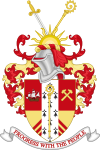
Stratford is a town in east London, England, within the ceremonial county of Greater London. Until 1965 it was within the historic county of Essex. Part of the Lower Lea Valley, Stratford is situated 6 miles (9.7 km) east-northeast of Charing Cross, and includes the localities of Maryland and East Village.
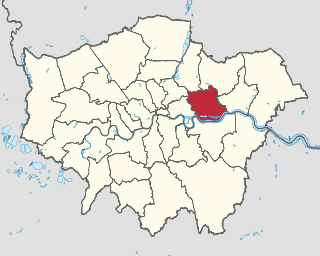
The London Borough of Newham is a London borough created in 1965 by the London Government Act 1963. It covers an area previously administered by the Essex county boroughs of West Ham and East Ham, authorities that were both abolished by the same act. The name Newham reflects its creation and combines the compass points of the old borough names. Situated in the East London part of Inner London, Newham has a population of 387,576, which is the third highest of the London boroughs and also makes it the 17th most populous district in England. The local authority is Newham London Borough Council.
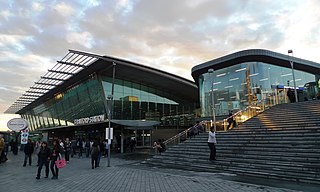
Stratford is a major multi-level railway station which rates as the 5th busiest station in Britain, serving the district of Stratford and the mixed-use development known as Stratford City, in the London Borough of Newham, east London. It is served by the London Underground, London Overground, Docklands Light Railway (DLR) and is also a National Rail station on the West Anglia Main Line and the Great Eastern Main Line, 4 miles 3 chains (6.5 km) from Liverpool Street. It is also the busiest station on the Tube network outside Travelcard Zone 1.
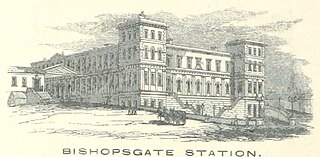
Bishopsgate was a railway station located on the eastern side of Shoreditch High Street in the parish of Bethnal Green on the western edge of the East End of London and just outside the City of London.
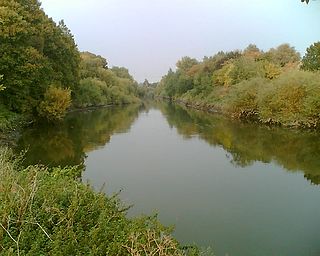
Hackney Marshes is an area of open space in London's Lower Lea Valley, lying on the western bank of the River Lea. It takes its name from its position on the eastern boundary of Hackney, the principal part of the London Borough of Hackney, and from its origin as an area of true marsh.
The Northern & Eastern Railway (N&ER) was an early British railway company, that planned to build a line from London to York. Its ambition was cut successively back, and it was only constructed from Stratford, east of London, to the towns of Bishop's Stortford and Hertford. It was always short of money, and it got access to London over the Eastern Counties Railway (ECR). It was built at the track gauge of 5 ft, but it converted to standard gauge in 1844.
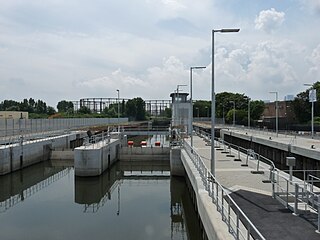
Bow Back Rivers or Stratford Back Rivers is a complex of waterways between Bow and Stratford in east London, England, which connect the River Lea to the River Thames. Starting in the twelfth century, works were carried out to drain Stratford Marshes and several of the waterways were constructed to power watermills. Bow Creek provided the final outfall to the Thames, and the other channels were called Abbey Creek, Channelsea River, City Mill River, Prescott Channel, Pudding Mill River, Saint Thomas Creek, Three Mills Back River, Three Mills Wall River and Waterworks River.

The Greenway is a 7-kilometre (4.3 mi) long footpath and cycleway in London, mostly in the London Borough of Newham, on the embankment containing the Joseph Bazalgette Northern Outfall Sewer.

The Lower Lea Valley is the southern end of the Lea Valley which surrounds the River Lea in eastern Greater London. It is part of the Thames Gateway redevelopment area and was the location of the 2012 Summer Olympics.

East London is the northeastern part of London, United Kingdom. Located east of the ancient City of London and north of the River Thames as it begins to widen, East London developed as London's docklands and the primary industrial centre. The expansion of railways in the 19th century encouraged the eastward expansion of the East End of London and a proliferation of new suburbs. The industrial lands of East London are today an area of regeneration, which are well advanced in places such as Canary Wharf and ongoing elsewhere.

Stratford International is a National Rail station in Stratford and a separate Docklands Light Railway (DLR) station nearby, located in East Village in London. Despite its name, no international services stop at the station; plans for it to be served by Eurostar trains never came to fruition. The National Rail platforms are, however, served by domestic Southeastern trains on the High Speed 1 route originating at St. Pancras, with interchange to Eurostar trains at other stops along the route. On the DLR it is a terminus – one of seven end-of-the-line termini – for local services via Canning Town and London City Airport.
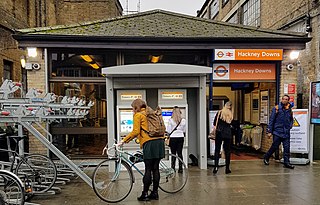
Hackney Downs is a London Overground and National Rail station in Hackney Central and serves the old common land of Hackney Downs in Lower Clapton in the London Borough of Hackney, it is on the Lea Valley lines and West Anglia Main Line. It is 2 miles 78 chains (4.8 km) down the line from London Liverpool Street and has a direct passenger link to Hackney Central station, providing interchange with the North London line of the Overground network.

Queen Elizabeth Olympic Park is a sporting complex and public park in Stratford, Hackney Wick, Leyton and Bow, in east London. It was purpose-built for the 2012 Summer Olympics and Paralympics, situated adjacent to the Stratford City development. It contains the Olympic stadium, now known as the London Stadium, and the Olympic swimming pool together with the athletes' Olympic Village and several other Olympic sporting venues and the London Olympics Media Centre. The park is overlooked by the ArcelorMittal Orbit, an observation tower and Britain's largest piece of public art.

The London Borough of Newham, in spite of being one of the more crowded areas of London, has over 20 parks within its boundaries, as well as smaller recreation grounds. The larger parks in the Borough include:
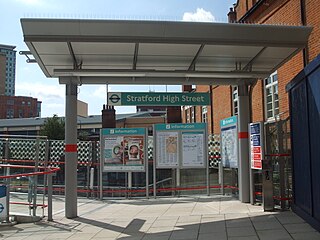
Stratford High Street is a Docklands Light Railway station in Stratford in London, England. It is located on the Stratford International branch of the Docklands Light Railway, which opened on 31 August 2011. The site was the location of an earlier railway station from 1847 to 1957, known initially as Stratford Bridge and later as Stratford Market - after the nearby wholesale fruit and vegetable market.

Stratford Works was the locomotive-building works of the Great Eastern Railway situated at Stratford, London, England. The original site of the works was located in the 'V' between the Great Eastern Main Line and the Stratford to Lea Bridge route and in the early years was also the home of Stratford Locomotive Depot. The final part of the works closed in 1991.
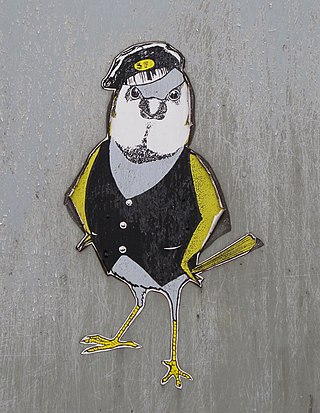
Stratford TMD was a traction maintenance depot located in Stratford, London, England close to the Great Eastern Main Line. It was located just west of Stratford station, on a site now occupied by Stratford International station. The depot was at one time the biggest on the London and North Eastern Railway with locomotives covering duties from express services to freight workings in London's docks.
There were a number of engine sheds and railway works located in York. The large York North engine shed became the National Railway Museum in 1975.

York Wagon Works was a railway freight wagon works built in York, England, by the North Eastern Railway in 1867. Wagon manufacturing ceased on the site in the 1960s.
Stratford Market was a wholesale fruit and vegetable market, located in Stratford in the London Borough of Newham. Opened in 1879 by the Great Eastern Railway as a competitor to Spitalfields Market in the City of London, the market closed in 1991 and consolidated at the New Spitalfields Market in Leyton. The site is now home to Stratford Market Depot.






















